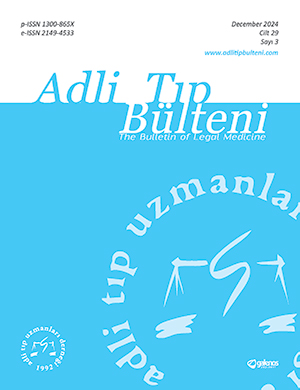Dyadic Death via Cut-throating: A Case Report
DOI:
https://doi.org/10.17986/blm.1712Keywords:
Boğazlama, Otopsi, Çifte Ölüm, Cinayet, İntihar, kesici alet yaralanmasıAbstract
Cut-throating is most commonly homicidal, but can also occur as a result of suicide or accident. We present two cases of cut-throating consist of one homicide and one suicide handled by the husband in the same scene. Causes of death for both are reported as “as a result of bleeding due to major vascular damages caused by sharp force injury”. According to judicial investigation; the couple had been in process of divorcing and that night the man firstly killed his wife and then himself by cut-throating with a knife while their kids present. We present this case because it involves both homicide and suicide handled by the same hands with the same method in an event. We aimed to emphasize the importance of the differences in the findings obtained from the crime scene and the corpse in determining the origin in deaths by cut-throating.
Downloads
References
Erkol ZZ, Büken B. Yaralar. İçinde: Celbiş O, İşcan MY, editörler. Adli bilimler: kimlik, yeniden yapılandırma ve ölüm. Ankara: Akademisyen Tıp Kitabevi; 2016, ISBN: 978-605-9354. s. 99-126.
Gök E, Fedakar R, Saka NE. Boğazlama ile intihar olgusu. Adli Tıp Dergisi. 2017;31(3):164-168. https://doi.org/10.5505/adlitip.2017.32559
Fukube S, Hayashi T, Ishida Y, Kamon H, Kawaguchi M, Kimura A, Kondo T. Retrospective study on suicidal cases by sharp force injuries. Journal of Forensic and Legal Medicine. 2008;15(3): 163-167. https://doi.org/10.1016/j.jflm.2007.08.006
Knight B, Saukko P, editors. Forensic Pathology 4th ed. London: CRC Press; 2016, ISBN: 978-1-4441-6508-1. p. 229-239.
Ozdemir B, Celbis O, Kaya A. Cutthroat injuries and honor killings: review of 15 cases in eastern Turkey. Journal of Forensic and Legal Medicine. 2013;20(4):198-203. https://doi.org/10.1016/j.jflm.2012.09.011.
Karger B, Niemeyer J, Brinkmann B. Suicides by sharp force: typical and atypical features. International Journal of Legal Medicine. 2000;113:259-262. https://doi.org/10.1007/s004149900093
Altun G. Planned complex suicide: report of three cases. Forensic Science International. 2006;157(2-3):83-86. https://doi.org/10.1016/j.forsciint.2005.04.039
Karlsson T. Multivariate analysis (‘Forensiometrics’)-A new tool in forensic medicine: Differentiation between sharp force homicide and suicide. Forensic Science International. 1998; 94(3):183-200. https://doi.org/10.1016/S0379-0738(98)00065-6
Vidanapathirana M, Samaraweera JC. Homicidal cut throat: the forensic perspective. Journol of Clinical and Diagnostic Research. 2016:10(3):GD01–GD02. https://doi.org/10.7860/JCDR/2016/17997.7411
Downloads
Published
Issue
Section
License
Copyright (c) 2025 The Bulletin of Legal Medicine

This work is licensed under a Creative Commons Attribution 4.0 International License.
The Journal and content of this website is licensed under the terms of the Creative Commons Attribution (CC BY) License. The Creative Commons Attribution License (CC BY) allows users to copy, distribute and transmit an article, adapt the article and make commercial use of the article. The CC BY license permits commercial and non-commercial re-use of an open access article, as long as the author is properly attributed.

